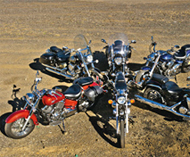
Tuning fork twang 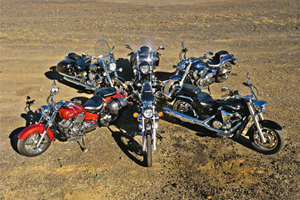
Virago 250, XVS650 Classic, XVS950A, XVS1100A Classic, XVS1300A, XV1900AS Roadliner
Words: Stuart Woodbury Photos: Nick Wood
Your response to our overview and comparison of the Kawasaki Cruiser range was so positive that we decided to do the same up with the Yamaha cruiser lineup.
These six bikes start with the baby Virago and progress to the massive 1900 Roadliner. You might well ask, “How the hell can you compare these?” — but read on and be surprised.
The test riders were enduro racers Phil and Scott, Mike Grant, Ian (the bike exchanger), our great photographer Nick Wood and I. We each chose a bike for our trip up, then we set down our thoughts over a coffee. On the return trip, we all sampled each of the six bikes and added further impressions.
Virago 250 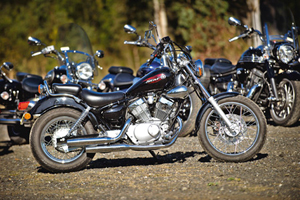
Nick wanted to ride the Virago for his main assessment and at the end of the day was obviously very impressed with just how well it cruised with the larger machines.
“Although it lacks torque, in context it is a perfect little performer that’s more than happy to purr along between 80-100km/h even though it does need a bit of a boost up the hills,” he said.
“The Virago’s handling is light; turn-in is dead easy, supplying plenty of feedback through the bars, but at highway speeds the rear shocks bottomed out on bumpy bends. Braking was neutral with a good amount of power, considering its size. Ergonomics are well set out: the seat is comfortable, the bar position was set up level with nice width and the footpegs aren’t buzzy.”
After Ian had his turn, he said, “The Virago can be ridden just as fast through corners as the other cruisers here — what a surprise!”
“What a bloody ripper!” Mike said. “It’s just so easy to ride. What a great learner’s bike.”
I reckon the Virago is a perfect, cheap commuter, great for riders who want a lightweight bike and it’s a great LAMS machine. Of course, the reason Viragos have been around for such a long time is that they are so well built and famous for being near bulletproof — and they hold their resale value.
We all loved the Virago because it just does all you could ask of it.
“The Virago can be ridden just as fast through corners as the other cruisers here — what a surprise!”
Quickspecs
Model: Yamaha Virago 250
Price: $6299 (plus on-road charges)
Warranty: Two years, unlimited distance
Servicing km intervals: Every 10,000km
Engine: Air-cooled, SOHC, V-twin cylinder, 4-stroke
Bore × stroke: 49×66mm
Displacement: 249cc
Compression: 10.0:1
Power: n/a
Torque: n/a
Transmission: Five-speed, wet multi-plate clutch, chain final drive
Suspension: Front, telescopic fork, non-adjustable, travel 140mm. Rear, twin-shock, adjustable preload, 100mm travel
Dimensions: Seat height 685mm, kerb weight 147kg, fuel capacity 10L, wheelbase 1490mm
Tyres: Front, 110/90/R18. Rear, 130/90/R15
Frame: Steel double cradle
Brakes: Front, single 268mm disc with dual-piston caliper. Rear, 130mm drum
Fuel consumption: 4.27L/100km, premium unleaded
Theoretical range: 234km
Colours: Raven
Verdict: Lil’ ripper!
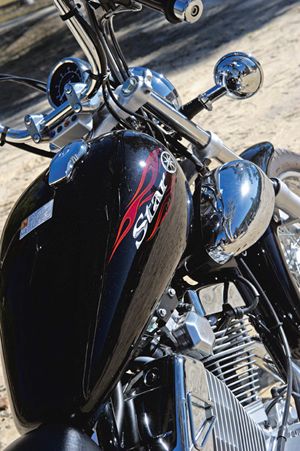
XVS650 Classic
This was my main steed and it turned out to be the only one in the range we all were a bit disappointed with. The engine has no real usable power for touring — in fact, the Virago is faster!
The 650 goes OK under 100km/h so we suggest it would make a good commuter cruiser. Considering its 247kg wet weight, handling is light and it’s easy to manage through tight traffic.
Braking is a worry; the front virtually has no feel or power and once or twice had me wondering if it was going to stop. The rear brake is a bit wooden and overstepping the mark with your right foot will see the wheel locking up.
On the positive side, the 650 Classis is very comfortable. It’s designed for someone under 185cm but, with a relaxing bar width, commuting and arriving at your destination hassle free is what you’ll get.
Phil jumped on the 650 on the return trip and couldn’t wait to get off it, saying he preferred the Virago because it was “more fun”.
Fit and finish was another area we felt was lacking on the 650: it just felt cheap compared to the others here.
Having said all that, the latest sales figures from the FCAI reveal that the XVS650 is the highest-selling cruiser, so it must be the price that appeals most.
The best-selling cruiser in Australia but it lacks usable touring power.
Quickspecs
Model: Yamaha XVS650A Classic
Price: $10,999 (plus on-road charges)
Warranty: Two years, unlimited distance
Servicing km intervals: Every 10,000km
Engine: Air-cooled, SOHC, 70-degree V-twin cylinder, 4-stroke
Bore × stroke: 81×63mm
Displacement: 649cc
Compression: 9.0:1
Power: 30kW @ 6500rpm
Torque: 50.1Nm @ 3000rpm
Transmission: Five-speed, wet multi-plate clutch, shaft final drive
Suspension: Front, telescopic fork, non-adjustable, travel 140mm. Rear, monoshock, adjustable preload, 98mm travel
Dimensions: Seat height 711mm, kerb weight 247kg, fuel capacity 16L, wheelbase 1625mm
Tyres: Front, 130/90//R16. Rear, 170/80/R15
Frame: Steel double cradle
Brakes: Front, single 298mm discs with dual-piston caliper. Rear, 200mm drum
Fuel consumption: 4.81L/100km, premium unleaded
Theoretical range: 332km
Colours: Candy Red; Deep Blue
Verdict: Commuting is its calling card
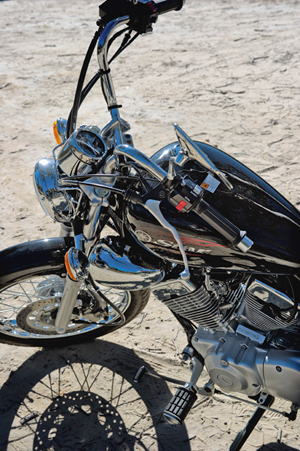
XVS950A
Mike Grant claimed the 950 for the ride up and it turned out that we all loved riding this one.
“The 950 design follows the custom styling handbook closely,” Mike said. “It looks long and low with a scalloped seat and wide handlebars. I like the attention to detail on the bike.
“There are no bits that look tacked on or crudely fitted, as is the case on some other brand middleweight rivals. Of note is the top of the triple clamp, which is an impressive clean-cut billet.
“The motor is a peach. It thrums away with a pleasant rumble and pulls strongly and willingly for a middleweight powerplant. It’s free of vibration, the fuelling is smooth and progressive and it just generally feels nice to ride.
“The gearshift is also spot on. Changes are light and positive and are accompanied by a satisfying click. What I particularly liked was that, when stopped, it nudges into neutral with barely a thought, which makes negotiating traffic much more relaxed and pleasant than otherwise.
“The seating position is comfortable and roomy and the controls fall easily to hand, which is a promising start. Once underway though you will need to keep things steady and smooth because the footboards start scraping very quickly and the suspension doesn’t absorb bumps all that well. The steering, although pleasingly light and positive, is slow to respond to input.”
Ian said, “I love the balanced handling and the engine is just so smooth and punchy.”
Scott also liked how easy it is to ride: “I especially like that even though it’s a 950 it looks like a bigger-capacity cruiser. I love the balanced handling and the engine is just so smooth and punchy.”
Quickspecs
Model: Yamaha XVS950A
Price: $13,999 (plus on-road charges)
Warranty: Two years, unlimited distance
Servicing km intervals: Every 10,000km
Engine: Air-cooled, 4 valve per cylinder SOHC, V-twin cylinder, 4-stroke
Bore × stroke: 85×83mm
Displacement: 942cc
Compression: 9.0:1
Power: 38.6kW @ 6000rpm
Torque: 76.8Nm @ 3000rpm
Transmission: Five-speed, wet multi-plate clutch, belt final drive
Suspension: Front, 41mm telescopic fork, non-adjustable, travel 135mm. Rear, monoshock, adjustable preload, 110mm travel
Dimensions: Seat height 675mm, kerb weight 278kg, fuel capacity 17L, wheelbase 1685mm
Tyres: Front, 130/70/R18. Rear, 170/70/R16
Frame: Steel double cradle
Brakes: Front, single 320mm disc with dual-piston caliper. Rear, 298mm disc, single-piston caliper
Fuel consumption: 4.36L/100km, premium unleaded
Theoretical range: 389km
Colours: Deep Blue; Raven
Verdict: Will hold its own with the big boys
XVS1100A Classic
Ian was pretty keen on the Classic from the start: “I like the classic styling; it looks sleek with the smooth flowing panniers. The finish looks good and it has a screen, so on this cold morning I knew which one I wanted to be on.”
After his ride, Ian said, “The engine has strong torque that makes touring smooth but it doesn’t want to rev all that much; nonetheless, for touring it’s well sorted. Cruising between 90-110km/h is where it feels best.”
As far as handling, Ian said, “It’s a bit on the soft side; the front dives just a bit too much on turn-in. Over rough patches, the suspension gets a bit unsettled. Brakes return a good amount of feel and power is reasonable as well.
“Comfort is set out [with] the touring rider in mind, the seat is good and the reach to the bars is relaxing.”
Mike’s pick of the six-bike lineup was the 1100: “I like the user-friendly power, comfy riding position, the screen works well and the classic styling really appeals to me.”
Nick gave the 1100 the thumbs-up for its screen and comfortable seat.
Phil was not so much of a fan, but he’d just ridden the Roadliner and, after enjoying its huge engine, he felt the 1100 was a “bit doughy”. But he liked “the user-friendly power [and] comfy riding position. The screen works well and the classic styling really appeals.”
Quickspecs
Model: Yamaha XVS1100A Classic
Price: $15,699 (plus on-road charges)
Warranty: Two years, unlimited distance
Servicing km intervals: Every 10,000km
Engine: Air-cooled, SOHC, 75-degree V-twin cylinder, 4-stroke
Bore × stroke: 95×75mm
Displacement: 1100cc
Compression: 8.3:1
Power: 45kW @ 5750rpm
Torque: 85Nm @ n/a
Transmission: Five-speed, wet multi-plate clutch, shaft final drive
Suspension: Front, telescopic fork, non-adjustable, travel 140mm. Rear, monoshock, adjustable preload, 113mm travel
Dimensions: Seat height 710mm, kerb weight 285kg, fuel capacity 17L, wheelbase 1645mm
Tyres: Front, 130/90/R16. Rear, 170/80/R15
Frame: Steel double cradle
Brakes: Front, twin 298mm discs with dual-piston calipers. Rear, 282mm disc, single-piston caliper
Fuel consumption: 5.52L/100km, premium unleaded
Theoretical range: 308km
Colours: Raven/Cream
Verdict: User-friendly cruising
XVS1300A
Scott was the lucky one to have most time on the XVS1300A — and what a great bike it reveals itself to be.
“The power is strong and very enjoyable. Its operation is totally smooth and is matched well to the gearbox ratios. The gear change is a nice little snick into each gear and the medium weight of the clutch is easy to use.
“Its handling entices you to have fun; turn-in is weighted just right and, once over into a corner, there’s ample amount of clearance (for a cruiser) and the suspension feels planted over the rough stuff.
“The brakes feel powerful and I never got into a position that I needed to use them aggressively, since the bike was already slowed down.”
Nick agreed: “I really like that I can use the brakes into a corner and not feel as though I’ve done too much or too little to allow my entry into a corner be at a comfortable pace.”
Scott found the ergonomics “fantastic! I like the bar height and width; it gives you a comfy ride yet still retains a bit of that muscle look. This is a cruiser I could live with.”
The seat was a favourite with the entire group: it’s wide, plush and one that we all agreed we could sit on all day.
Ian was in love: “I could buy one of these — it just does everything I want and is really comfy, something I want from a cruiser. This bike has the appeal and muscle you look for in a cruiser. The finish is a cut above the others and is on par with the Roadliner, which is a piece of art in its own right.”
After my turn, I also love the comfort, the strong power up high in the rev range and the low-down pull from standstill at the lights. Its handling is the best of the bunch; it just does what you want it to. I came through a series of blind twisties on the 1300 and held a speed that I’ve done on some more fancied “head down, bum up” machines.
Its handling entices you to have fun.
Quickspecs
Model: Yamaha XVS1300A
Price: $17,299 (plus on-road charges)
Warranty: Two years, unlimited distance
Servicing km intervals: Every 10,000km
Engine: Liquid-cooled, 4 valve per cylinder DOHC, V-twin cylinder, 4-stroke
Bore × stroke: 100×83mm
Displacement: 1304cc
Compression: 9.5:1
Power: 52.4kW @ 5500rpm
Torque: 106Nm @ n/a
Transmission: Five-speed, wet multi-plate clutch, belt final drive
Suspension: Front, telescopic fork, non-adjustable, travel 135mm. Rear, monoshock, adjustable preload, 110mm travel
Dimensions: Seat height 690mm, kerb weight 304kg, fuel capacity 19L, wheelbase 1690mm
Tyres: Front, 130/90/R16. Rear, 170/70/R16
Frame: Steel double cradle
Brakes: Front, twin 298mm discs with dual-piston calipers. Rear, 298mm disc, single-piston caliper
Fuel consumption: 6.08L/100km, premium unleaded
Theoretical range: 312km
Colours: Raven with Red Stripe
Verdict: Cream of the crop
XV1900AS Roadliner
Now we move to the art deco piece, the big Roadliner — even the name sounds massive.
The rider for the job was “The Man” Phil who reckons, “Styling is the main focus on this bike: the art deco theme. The first thing that draws your attention is the dash, taken straight from the 1930s. Next your eyes move to the flowing lines and teardrop shape of the headlight and its casing. New for 2011 is the lush paintwork featuring subtle flames. I also like that the chrome has not been overdone.
“Its power delivery is ultra smooth and, with 167-odd Newton metres of torque, the Roadliner pulls stronger than an ox.”
Nick was the most surprised by the Roadliner’s torque: “This thing just keeps pulling. It’s the kind of cruiser that will be great for two-up riding. It has so much torque.”
Phil said he needed to use all his muscle power to turn the Roadliner into a corner “but once in there, it feels settled and controllable”.
Mike had the same reaction: “It’s quite heavy and slow to turn in but once there it’s fine.”
Phil loved the ergonomics on the Roadliner: “The seat is so plush and the seat-to-footboard position really suits a bigger bloke. The screen provides good wind protection.”
I agreed with Phil on the riding position but the rest of us found the screen buffeted our heads way too much. For my part, the buffeting was so bad I couldn’t see clearly at speeds over 100km/h. Thankfully, the screen is easily removed via the key and this makes it a far more comfortable bike to ride.
Opinion varied on the front brake. Phil said there isn’t much feel but Mike and Ian felt there is good feel and plenty of power for such a big machine. I contribute some of the heavy turn-in to the front brakes — while it’s still heavy off the brakes, if you use them right into the apex you need more muscle to crank it over.
The leather panniers look large but once you open them up you realise they’re actually a bit small. They would probably be OK for one rider and a couple of days’ riding but the panniers on the XVS1100A Classic offer nearly double the usable space.
“This thing just keeps pulling. It’s the kind of cruiser that will be great for two-up riding. It has so much torque.”
Quickspecs
Model: Yamaha XV1900AS Roadliner
Price: $24,099 (plus on-road charges)
Warranty: Two years, unlimited distance
Servicing km intervals: Every 10,000km
Engine: Liquid-cooled, 4 valve per cylinder DOHC, V-twin cylinder, 4-stroke
Bore × stroke: 100×118mm
Displacement: 1854cc
Compression: 9.48:1
Power: 73.6kW @ 4250rpm
Torque: 167.8Nm @ 2500rpm
Transmission: Five-speed, wet multi-plate clutch, belt final drive
Suspension: Front, 41mm inverted fork, adjustable preload, travel 130mm. Rear, monoshock, adjustable preload, 110mm travel
Dimensions: Seat height 705mm, kerb weight 346kg, fuel capacity 17L, wheelbase 1715mm
Tyres: Front, 130/70/R18. Rear, 190/60/R17
Frame: Aluminium double cradle
Brakes: Front, twin 298mm discs with four-piston calipers. Rear, 320mm disc, single-piston caliper
Fuel consumption: 6.24L/100km, premium unleaded
Theoretical range: 272km
Colours: Candy Red with flames; Raven with flames
Verdict: Art deco beauty
Decision time!
We don’t normally pick winners, but in this case it was such an easy decision that we couldn’t resist it.
The XVS1300A wins hands down with four of our votes (Scott, Nick, Ian and me). It’s a bike that feels great from the outset and has the power and appeal you look for in a cruiser.
Next comes the XVS950A, which is a fantastic all-round cruiser. It’s also the bargain of the bunch at just $13,999 and has a custom look straight off the showroom floor.
Up next is the 250 Virago. It’s a fun little cruiser that does the job well.
The big boy, the XVS1900AS Roadliner (Phil’s pick) comes in fourth. We all decided that with the screen off it may be ahead of the Virago on the table, but going on what is fitted, it sits below it.
The XVS1100A Classic (Mike’s choice) sits in fifth as a cruiser that’s for those after especially easy-to-handle power delivery.
The last one to make up the six is the XVS650 Classic. It just doesn’t cut it in this company on this kind of ride, but for commuting use we’d all be singing quite a different tune.
SW
